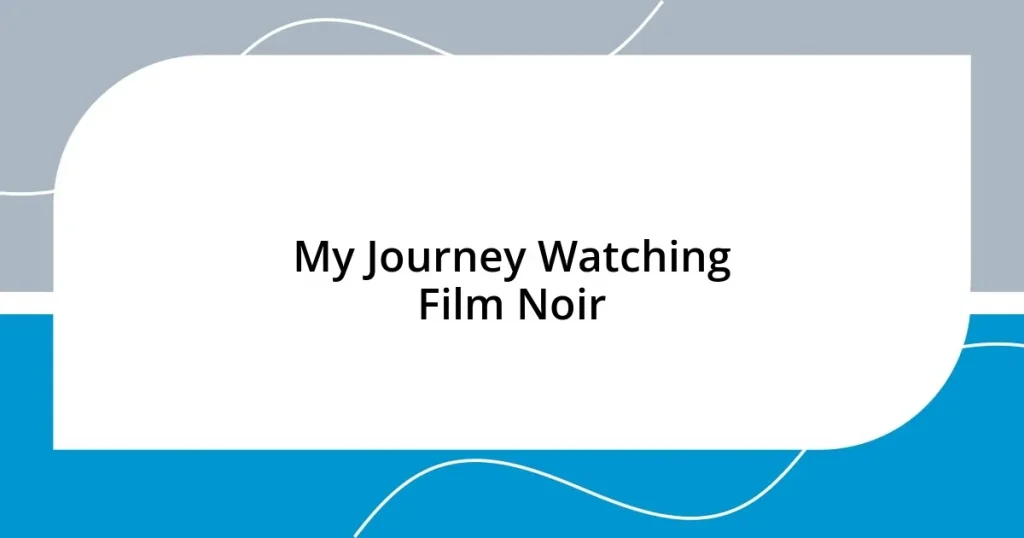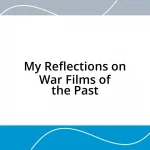Key takeaways:
- The author’s introduction to film noir began with “Double Indemnity,” which sparked a deep engagement with the genre’s exploration of human nature and moral complexity.
- Film noir has evolved from showcasing post-war disillusionment to incorporating psychological themes and contemporary issues in neo-noir films.
- Key characteristics of film noir include dark visual styles, morally ambiguous characters, and themes of betrayal and existential dread.
- Iconic films like “Sunset Boulevard” and “Chinatown” highlight the genre’s ability to resonate with personal and societal anxieties, making viewers reflect on their own experiences.
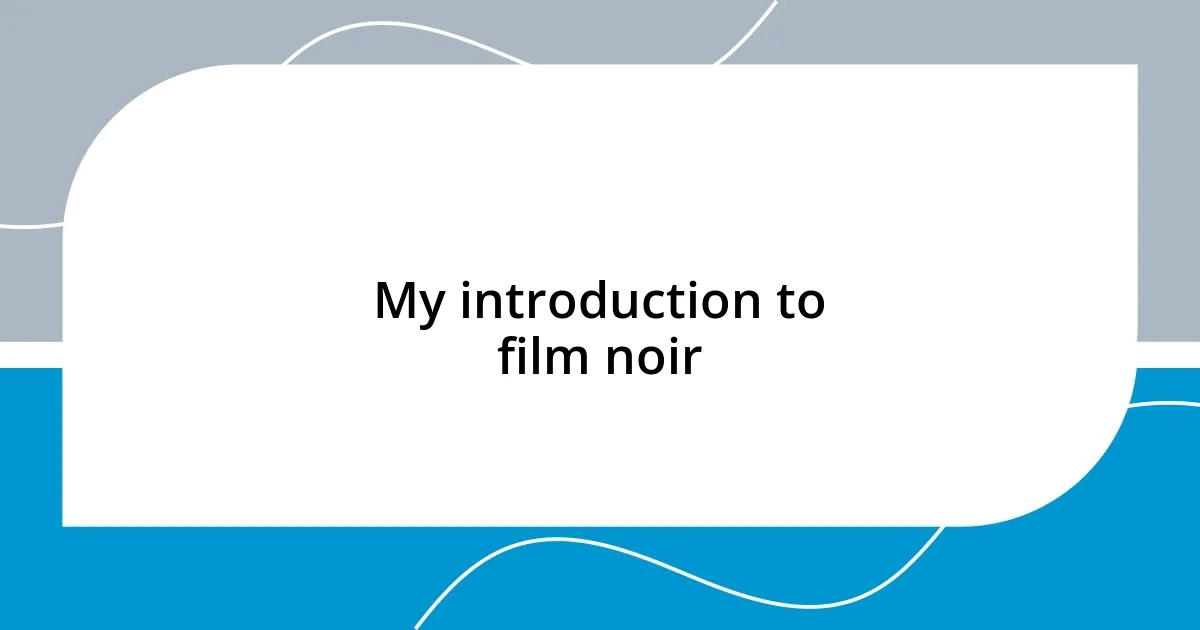
My introduction to film noir
My introduction to film noir was somewhat serendipitous. I stumbled upon “Double Indemnity” one rainy afternoon while flipping through channels. I remember being instantly captivated by the moody cinematography and the complex moral dilemmas that unfolded on screen. Was it the dimly lit scenes or the haunting narration that drew me in? Perhaps it was both.
As I watched, I felt the weight of a world where characters were constantly battling their own demons. I vividly recall the moment when I realized this wasn’t just another crime drama; it was a profound exploration of human nature. The characters were flawed and intense, making me question, “What would I do in their shoes?” This level of introspection transformed my viewing experience from passive to deeply engaging.
Diving deeper, I discovered how film noir often reflects societal anxieties of its time. The gritty realities portrayed in these films resonated with me, awakening a curiosity about the darker aspects of life. It made me appreciate the genre as a mirror to our own vulnerabilities and fears. Each film I watched seemed to resonate with a part of me, evoking emotions I didn’t know were there, and leaving me eager for more.
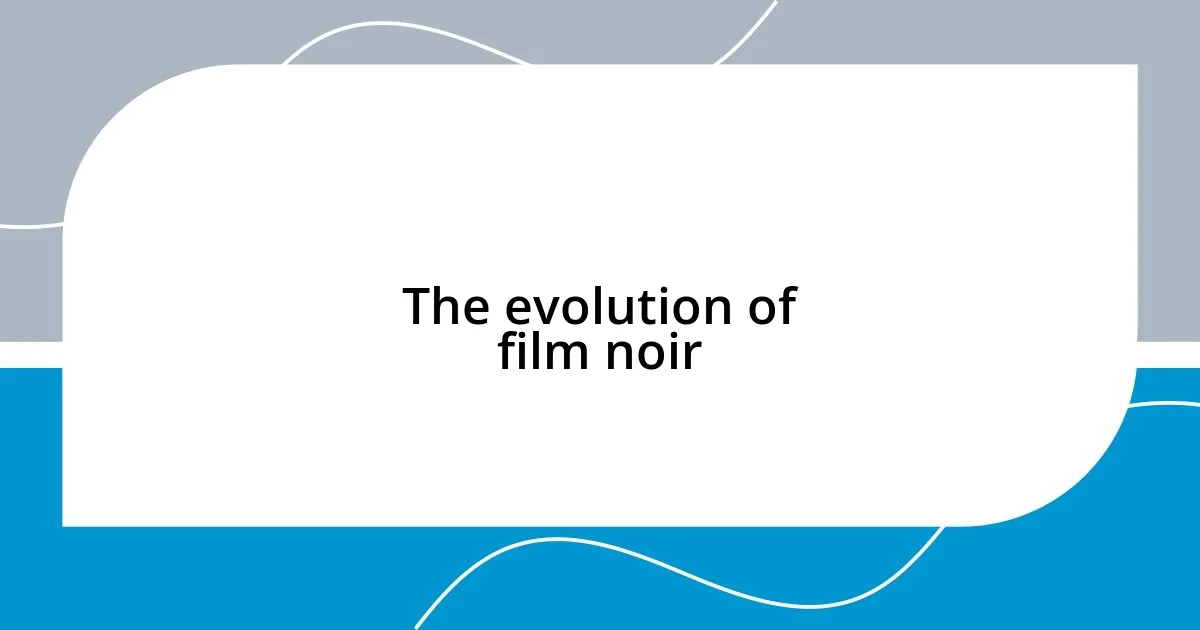
The evolution of film noir
Film noir has evolved significantly since its inception in the 1940s. Initially rooted in hard-boiled crime fiction, its distinctive style emerged as a response to the tumultuous social landscape of post-war America. I remember pondering how these films captured a sense of disillusionment; it was like peering into the collective psyche of a generation grappling with loss and uncertainty. The complex characters and bleak atmospheres resonated deeply, making me reflect on the fragility of morality in the face of dystopia.
As time passed, the genre began to morph, influenced by changing cultural contexts. In the late 1950s and 60s, I noticed a shift towards psychological themes, where the lines between hero and villain blurred even further. This transformation was captivating. It wasn’t just about crime; it hinged on personal struggles and existential crises. I was particularly drawn to films like “Chinatown,” where every twist left me questioning the reliability of truth and trust, mirroring my own experiences with betrayal in life.
Today, film noir continues to thrive, inspiring contemporary filmmakers who infuse classic elements with modern twists. I often find myself drawn to neo-noir films, which enhance traditional noir aesthetics while tackling issues like technology and social injustice. Watching these newer iterations feels like an ongoing dialogue with my past experiences, inviting me to dissect how far we’ve come—and how far we still have to go. The evolution of film noir isn’t just a chronological journey; it’s a reflection of our ever-changing human condition.
| Era | Characteristics |
|---|---|
| 1940s-1950s | Dark visuals, moral ambiguity, post-war disillusionment |
| 1960s-1970s | Psychological depth, blurring of hero/villain lines |
| 1980s-Present | Neo-noir elements, modern social issues, reflective of contemporary anxieties |
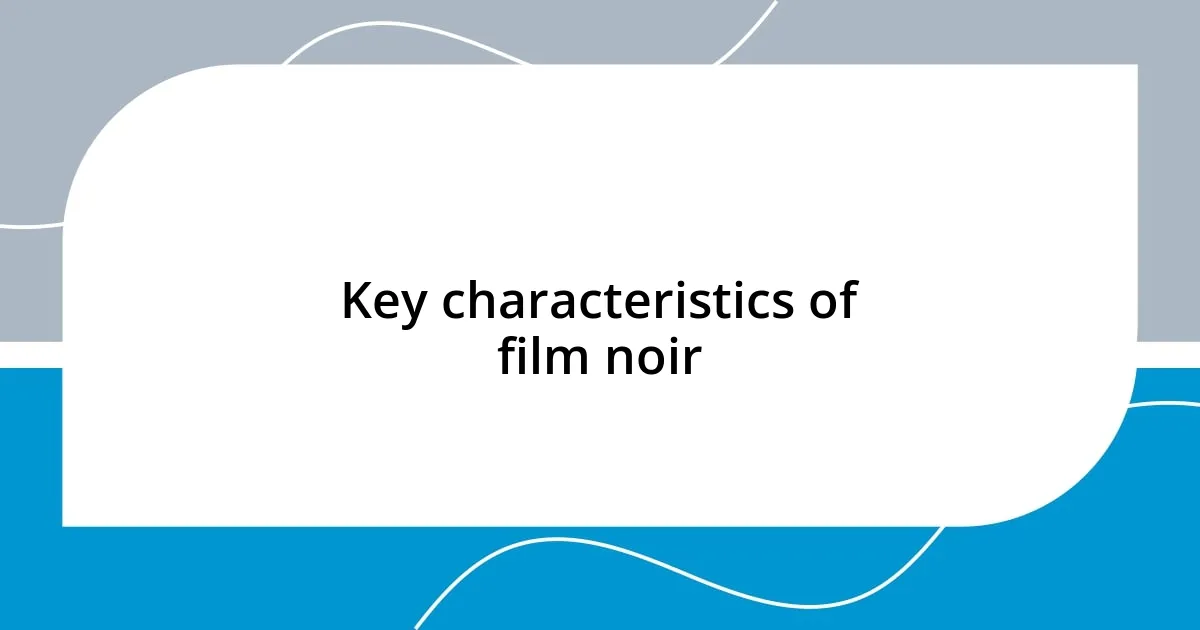
Key characteristics of film noir
Film noir is marked by a set of distinct characteristics that create its mesmerizing and often disturbing ambiance. One particularly striking feature is the use of chiaroscuro lighting, where stark contrasts between light and shadow evoke a sense of suspense and mystery. I can recall the first time I saw a character lit only by a slant of light, casting an eerie foreboding, and I felt my heart race in anticipation of what was to come. The world of film noir is often populated with morally ambiguous characters who grapple with inner demons and ethical dilemmas, making me ponder my own decisions and the gray areas in life.
Here are some key characteristics that define film noir:
- Visual style: Dark, high-contrast lighting and shadowy compositions.
- Narrative complexity: Twisted plots with non-linear storytelling.
- Character archetypes: Flawed heroes, femme fatales, and hard-boiled detectives.
- Themes: Moral ambiguity, betrayal, and existential crises.
- Atmosphere: A sense of dread, paranoia, and impending doom.
Every time I watch a film noir, I feel like I’m stepping into a world that mirrors my own complexities and uncertainties, where nothing is as simple as it seems. For instance, in “The Maltese Falcon,” the intricate web of deceit had me gripping my seat, questioning every character’s motives. That experience left me reflecting for days, reminding me that life, much like the genre itself, is often filled with surprises and shadows lurking beneath the surface.
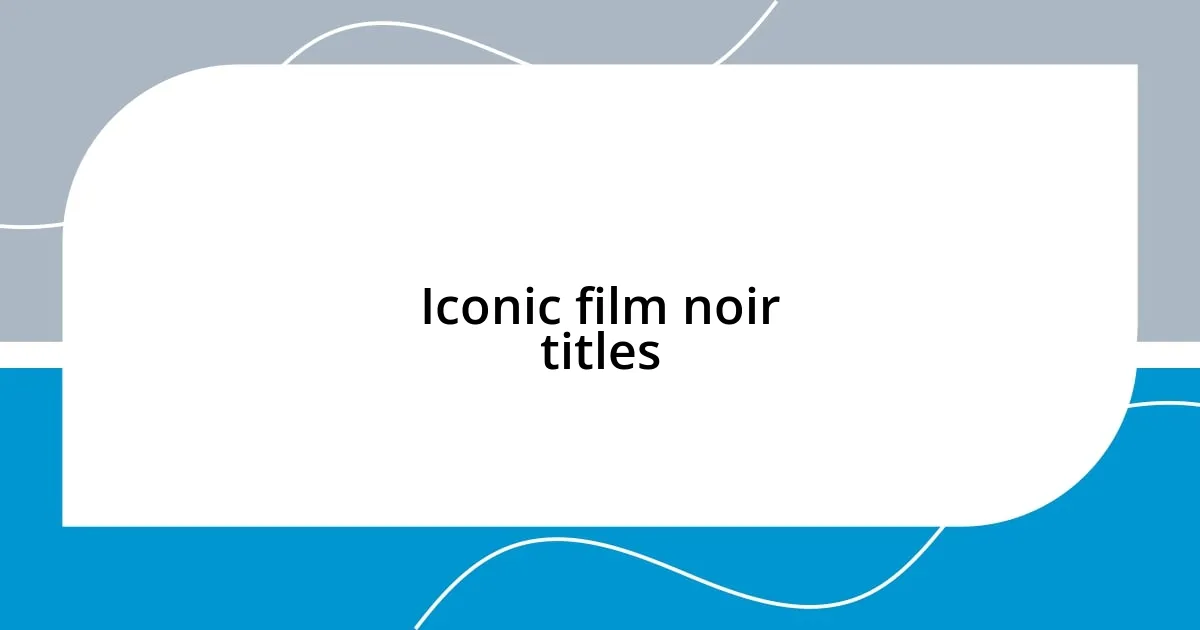
Iconic film noir titles
Film noir has given us unforgettable titles that linger in our minds long after the credits roll. Movies like “Double Indemnity” stir something deep within me; they encapsulate the genre’s essence, combining betrayal, lust, and a tightly woven plot. I still vividly remember the first time I watched it – the suspense was palpable, with every scene steeped in moral ambiguity. It left me wondering: how far would I go for love or money?
Another iconic entry, “Sunset Boulevard,” showcases the dark side of Hollywood’s glamour. I found myself entranced by the tragic tale of faded stars, which held a mirror to my own ambitions and fears. That haunting line, “I am big! It’s the pictures that got small!” resonated with me and sparked a contemplation on the elusive nature of fame. Have you ever felt the shadow of past successes haunting your present?
Then there’s “The Third Man,” where the atmospheric visuals and the haunting zither score pulled me into post-war Vienna, a city teetering on the edge of chaos. I remember how I struggled to shake off the film’s eeriness even after it ended; it resonated with a sense of existential dread that felt all too relatable. It underscores how film noir serves not just as entertainment but as a profound exploration of the human experience. Each title is a reflection, drawing me into a world where peril and intrigue blend seamlessly with our own fears and desires.
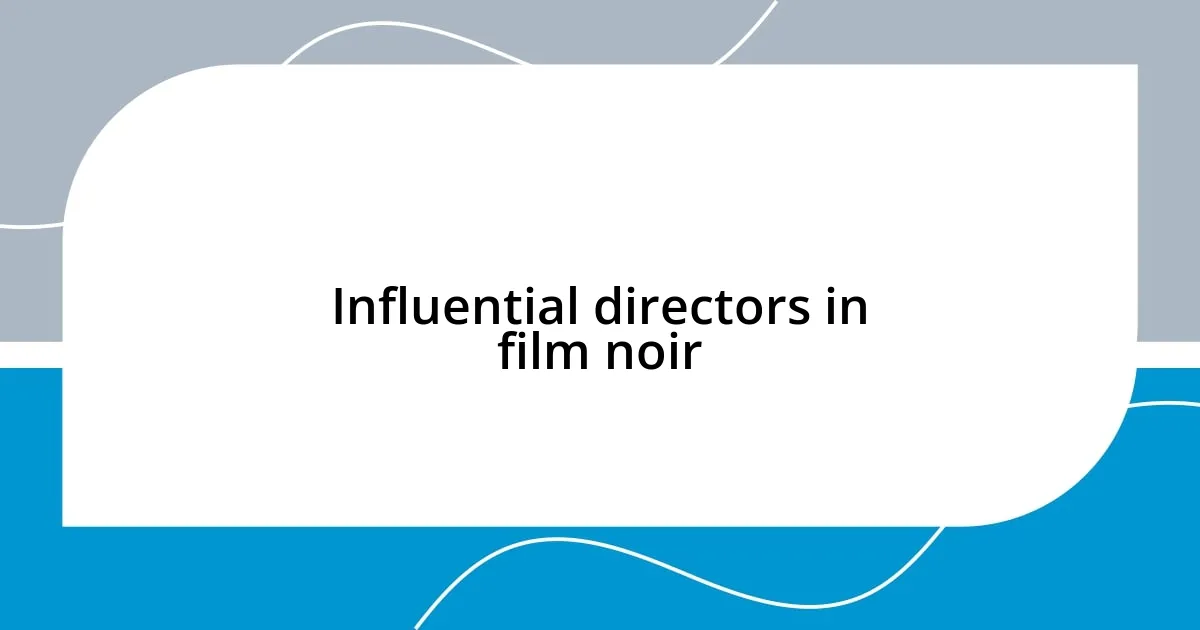
Influential directors in film noir
The world of film noir is truly indebted to its pioneering directors, who shaped the genre’s distinct style and storytelling. Take Billy Wilder, for example. His work on “Double Indemnity” not only established the template for the femme fatale but also immersed me in a web of deceit that had my heart racing. I remember being captivated by his ability to blend tension with dark humor, leaving me questioning the very nature of love and betrayal.
Another towering figure is Orson Welles, whose direction in “The Third Man” demonstrated a masterful use of unconventional angles and lighting. I can still feel the thrill of discovering post-war Vienna through his lens, where every shadow hinted at hidden agendas and betrayals. It’s fascinating how Welles crafted such an intricate narrative that mirrored the complexities of human morality, prompting me to consider how our environments shape our choices.
Finally, I can’t overlook the impact of Fritz Lang, particularly his film “M.” The way he depicted a psychological thriller left me with chills, highlighting the darkness not just within the characters, but within society itself. I often find myself reflecting on Lang’s exploration of innocence lost and evil lurking in unexpected places, asking—how do we recognize the shadows in our own lives? Film noir, in its haunting brilliance, serves as a reminder of the fragility of human nature and the choices that define us.
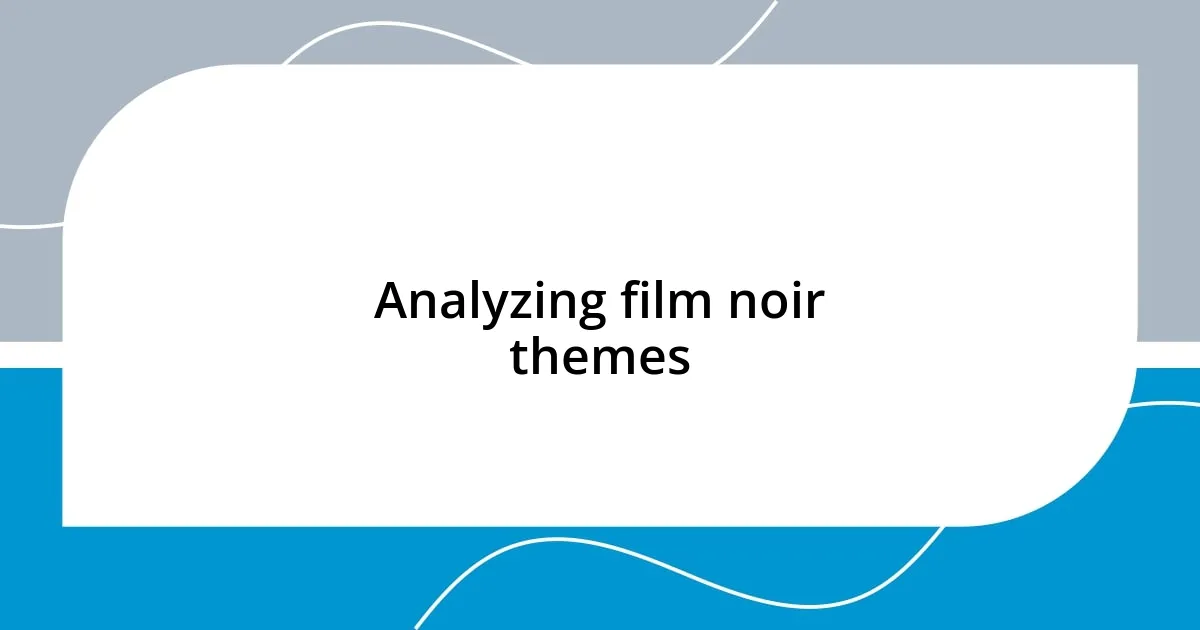
Analyzing film noir themes
Film noir themes often revolve around moral ambiguity and the struggle between good and evil, which deeply resonate with my experiences. Watching “Chinatown” for the first time was a revelation; the layers of deceit and corruption in the narrative made me ponder the fragility of justice. I found myself asking: what happens when those we trust lead us astray? This film, like many in the genre, poses questions that linger long after the final scene, reminding me that life is rarely black and white.
Another central theme is the pervasive sense of existential dread. I felt this acutely while watching “The Maltese Falcon.” The character of Sam Spade, with his cynical worldview and relentless pursuit of truth, seemed to reflect my own moments of disillusionment. There was a pressing realization for me: the search for meaning often involves navigating a labyrinth of betrayal and manipulation. Have you ever felt like your path was obscured by the shadows of others’ intentions?
Lastly, the elemental allure of the femme fatale is a theme that captivates me continuously. In films like “Gilda,” I couldn’t help but marvel at how these complex women encapsulate the intricate dance between desire and danger. There’s something both thrilling and cautionary about their charm—it’s like staring into a beautiful abyss. As I watched, I couldn’t shake off the question: do we sometimes invite chaos into our lives through our choices? This interplay between attraction and peril is a stark reminder of how alluring the dark side can be, echoing the struggles we all face with temptation and desire.
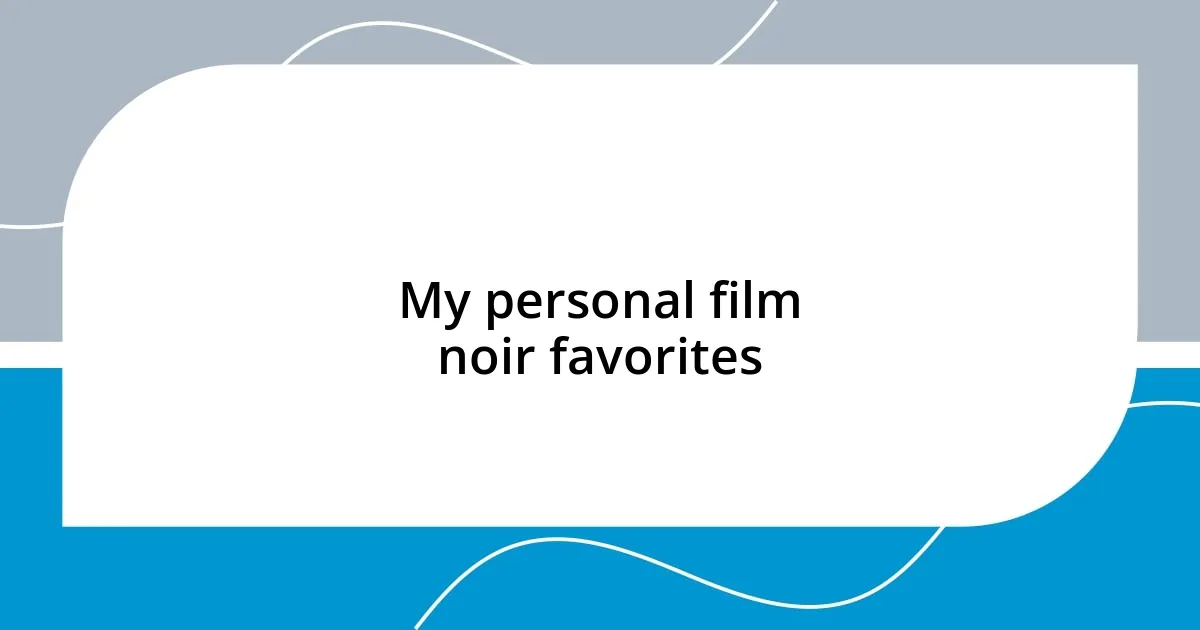
My personal film noir favorites
One of my all-time favorites in film noir has to be “Sunset Boulevard.” The haunting performance by Gloria Swanson as the faded star Norma Desmond still resonates with me. I often find myself reflecting on the thin line between fame and obsession. Watching her descend into madness, I couldn’t help but feel a mix of sympathy and horror. How easily can we lose ourselves in the pursuit of what we once cherished?
Then there’s “Laura,” with its mesmerizing blend of romance and mystery. The first time I saw it, I was completely entranced by the photograph of Laura Hunt that haunted Detective McPherson throughout the film. I remember thinking about how an image can evoke such powerful emotions and memories, drawing us into a world where the line between love and obsession blurs. Isn’t it fascinating how we can project our fantasies onto others, sometimes leading us down a path we’d never expect?
Lastly, “Out of the Past” stands out to me as a masterclass in mood and atmosphere. I felt engulfed by the tension and the weight of history that hangs over the characters. There’s a poignant moment when Robert Mitchum’s character confronts the choices of his past. I found myself asking, how much of our past truly defines us? Watching the film, I realized that every decision we make can echo throughout our lives—just like the highs and lows in the depths of a classic noir.











